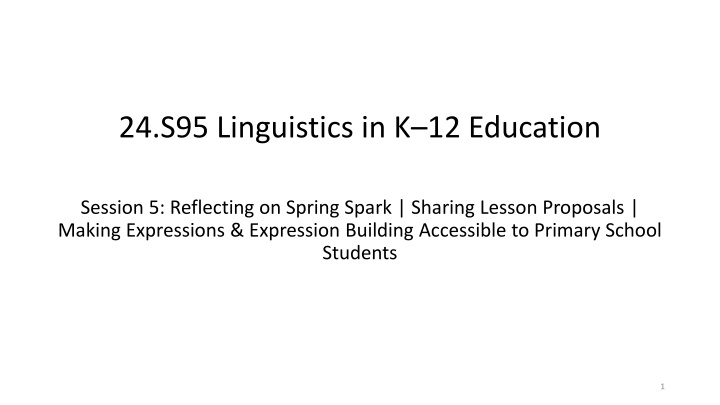
Reflecting on Linguistics in K12 Education: Lesson Proposals & Expression Building
Explore the reflections on Spring Spark, sharing lesson proposals, and making expressions and linguistic inquiry accessible in primary education. Learn from past works and plan engaging lessons for students.
Download Presentation

Please find below an Image/Link to download the presentation.
The content on the website is provided AS IS for your information and personal use only. It may not be sold, licensed, or shared on other websites without obtaining consent from the author. If you encounter any issues during the download, it is possible that the publisher has removed the file from their server.
You are allowed to download the files provided on this website for personal or commercial use, subject to the condition that they are used lawfully. All files are the property of their respective owners.
The content on the website is provided AS IS for your information and personal use only. It may not be sold, licensed, or shared on other websites without obtaining consent from the author.
E N D
Presentation Transcript
24.S95 Linguistics in K12 Education Session 5: Reflecting on Spring Spark | Sharing Lesson Proposals | Making Expressions & Expression Building Accessible to Primary School Students 1
Plan for today: Reflecting on Spring Spark Sharing Lesson Proposals/UbD Templates Making Expressions and Expression Building Accessible to Primary School Students Making Linguistic Inquiry Accessible through Problem Sets 2
Reflecting on Spring Spark The experience of designing the Spring Spark class The teaching experience Did the Spring Spark class meet our goals? Did you meet your personal goals? How could the Spring Spark experience be improved or developed? 3
Sharing Lesson Proposals Remind us about your partner teacher s class (subject area, students). What do you plan to do with the class? Desired results Evidence of understanding Learning plan Some things to think about as you plan your lesson: What do students need to know for your lesson to be accessible? What might the teacher and the students do after your lesson to apply or extend the teaching and learning experience? 4
Linguistics in Primary Education What goals did Fabb 1985, Denham 2010, and Oppenheimer et al. 2022 have in their work? What did they do to make exploring language accessible to primary school students? How did they explore expressions and expression building (morphology and syntax)? Are there any useful ideas for your lesson? 5
Making linguistic inquiry accessible Consider what students know and what you want them to learn Select a phenomenon that will be accessible to investigation and explanation Select an approach to the investigation: Bottom-up / top-down Textual analysis Problem set Fieldwork 6
Making linguistic inquiry accessible Motivate the problem: Serious inquiry begins when we are willing to be surprised by simple phenomena in nature (Chomsky 1993: 25) Grammaticality judgments can reveal a surprise, e.g., You can t say wanna whenever you wanna. Constrained sets of data can reveal a puzzle, e.g., You don t always add [s] to form a plural. Structure the investigation into do-able chunks to support students in the inquiry process Constrain the presentation of data Present a hypothesis with counterexamples Model scientific thinking 7
Investigating Tohono Oodham The O odham (formerly called the Papago) reside in northern Mexico and on four reservations, as well as towns and cities in southern Arizona. The Tohono O'odham Nation is a federally-recognized tribe that includes about 28,000 members occupying tribal lands in Southwestern Arizona. According to the Endangered Languages Project metadata, there are 14,000-15,000 fluent speakers of all ages. 8
Joyce L. Juans problem set on noun plurals Joyce is a guest in the culture. She is married to a Tohono O odham man and lives and teaches in the community, but she herself is not Tohono O odham. She attended the Linguistics Workshop that Wayne O Neil and I taught at the 2000 American Indian Language Development Institute. Joyce taught 5th graders in a public school on the Tohono O odham reservation and created a noun pluralization problem set for them. Reading ability from grade level 2.1 to 5.5 Knowledge of O odham: lists of words to fluency 9
Desired results Student goals: Greater appreciation of the complexity of Tohono O odham More familiarity with written form of Tohono O odham Greater awareness of some components of language Become familiar with and use the scientific method Contact Tohono O odham speakers and gather data 10
Desired results Teacher s goals: Learn more about the complexities of O odham Learn more about the students Work more closely with the students families Students and families will be persuaded to use their language more at home School work will become a family activity 11
MIT OpenCourseWare https://ocw.mit.edu 24.S95 Linguistics in K 12 Education, Spring 2023 For more information about citing these materials or our Terms of Use, visit https://ocw.mit.edu/terms.
